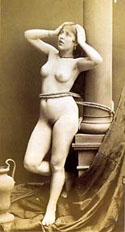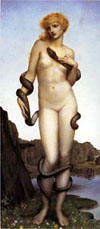The browser will either open the file, download it, or display a dialog.
|
"Exposed: The Victorian Nude" Alison Smith, ed., with contributions by Robert Upstone and others
—Brooklyn Museum of Art news release, April 2002 |
||||||
|
This exhibition evinces a curious disjuncture between content and form. The works on display are wide-ranging, well-chosen, and culled from a broad range of sources; the catalogue is exemplary in presenting concise essays on the larger themes addressed by the exhibition together with generous, scholarly entries for each work on display. The catalogue also succeeds in satisfying the curators' exposition imaginaire by including works which, for reasons of space, economics, or logistics, are not included in the show. Acknowledging both the excellence of the catalogue and the difficulties of putting together a major exhibition, it is nonetheless disappointing to see such fine efforts undermined both by the accompanying interpretative and promotional material and the ways in which works are grouped and displayed. These may be blunt instruments for the identification of "the exposure of the body" as "one of the most controversial issues in Victorian art," but they should serve to elucidate rather than obfuscate the subject. | |||||
| The handout that accompanied the exhibition at the Tate Britain (portions of which are quoted above) provides first a general introduction and a floor plan, then briefly summarizes the major themes raised by the grouping in each room. The plan is then explained as privileging thematic over chronological organization. The idea of an analytical objective and a thematic organization for an exhibition corresponds to Tate's sense of its own identity as defined by an interpretative mission. Yet the museum immediately sets itself up for the most glaring and significant omission of the exhibition: a signposting of what is meant by "the nude." The term is used repeatedly without qualification within the context of an exhibition designed to reinstate the problematic—and thus dynamic—nature of this category of artistic production. | ||||||
| To seek in the context of the exhibition the distinction drawn by Kenneth Clark between the "naked" and the "nude" might appear a reactionary response to an exhibition designed to suggest to the gallery-visiting public that nineteenth-century British works which privilege the naked form are indeed worthy of the critical attention for the most part denied to them by this most famous of British art historians. But it appears perverse in the extreme to omit a statement regarding the genealogy of this category of artistic production (or indeed how "the nude" came to be homogenized into such a category), and also a statement as to whether the works produced in the Victorian period inflected, transformed, consolidated, or fractured the inherited notion of what "the nude" was, should, or could be. If an historical epoch alone is an insufficient taxonomical pretext for an exhibition, then why not address or contest the idea (promoted by the 1999 exhibition The Artist's Model: From Etty to Spencer shown in London, York, and Nottingham) that at the beginning of the nineteenth century nudity in art was predominantly associated with the heroic male form, and that by the beginning of the twentieth century, "the nude" was implicitly gendered female? It is perhaps the attempt to differentiate the current exhibition from the earlier one, which showed many of the same works and addressed many of the same themes, that leads "Exposed: The Victorian Nude" to fail on its own terms. The attempt to bring nuance to a subject without acknowledging the genealogy of "the Victorian nude" as both a subject of inquiry and an exhibition category leads to a prevailing sense, not of a reinvigorated field of Victorian cultural studies shedding new light on an old subject, but of an old product being repackaged in the trappings of the present day. | ||||||
| It is of course unsurprising to find, in relation to the current imperatives of "access" and "relevance," the promotional material privileging terms such as "prestigious and dangerous" and "sexuality, desire and censorship." Nonetheless, having the word "Exposed" tacked on in front of "The Victorian Nude" is reminiscent of the 1970s marketing ploy of advertising all manner of products by the inclusion of a female model in swimwear. Perhaps it is too much to ask of an exhibition that claims the identification of the naked human form with high culture as one of the alibis used by Victorian artists to evade the charge of titillation that it address the titillation of its own marketing strategies. Nevertheless, it is valid to query why such strategies, when they are indeed relevant to the analysis of the subject, are absent from the display itself. While the photographic reproductions of Leighton's The Sluggard of 1885 (Tate) that adorn the promotional material for the exhibition are lit so as to emphasize the interplay of cold metal and oiled flesh, the marble and parian sculptures are for the most part lit in a way that fails to convey how such works could be simultaneously claimed as both expressions of a "higher sentiment" and agents of moral corruption. | ||||||
| It is undoubtedly one of the aims of Tate's interpretative project to privilege analysis without invoking the didactic. While it is an admirable objective to evoke within the space of the exhibition the contested nature of the production and reception of works featuring "the nude," this is done at the expense of clarity of expression and organization. It is true that the majority of themes a scholar might hope to see elucidated in relation to the works on display are to be found in the captions. However, these appear to be composed of statements taken from the body of the catalogue that are "fragmented and reassembled," "through processes of dissection and mutation," with none of the "self-conscious drive for perfection" attributed to the artists whose works we are asked to consider. | ||||||
|
The repeated disjuncture between the chronological and thematic imperatives in the exhibition also serves to confound the visitor. We are told that "the first room deals with work produced early in the Victorian era" when, in addition to works made in 1830s, 40s, and 50s (including paintings by Etty, Frost, and Mulready and graphic works by Holman Hunt, Millais, and other artists), it includes Millais's The Knight Errant of 1870 (Tate). Although seemingly trivial, this distracts attention from one of the most successful examples of the thematic approach: the opportunity to consider the early works of young artists who would significantly contribute to the shaping of what is seen as significant Victorian artistic production in relation to the works of the now largely forgotten artists who were shaping the idiom here identified as the "Anglo-Venetian nude." These graphic works could have served as a starting point for a unifying theme: how the disjuncture between the artist's studio works (the naked), private commissions (the erotic), and major works for public consumption (the nude) was, to a certain extent, eroded by the turn of the century (Orpen, Sickert, Whistler), when it became commonplace to emphasize the processes of art-making as expressions of an artistic creativity unconstrained by convention (the sketch, loose brushwork, naturalism). | |||||
| Tate's stated commitment to showing works in media other than painting and sculpture is well-served by this exhibition when, as in the last room ("The Modern Nude"), one aspect of artistic production (depictions of naked and scantily clad boys in landscape settings) is traced across different media. It is ill-served when "The Private Nude" is placed in two rooms, one dedicated to painting and half of the next one given over to graphic art, photography, and film. So it is that we find photographs depicting nude children by Cameron, Dodgson, and Plüschow placed next to an académie of a standing female figure by John Watson. Although the captions address the very different contexts of production and reception for each of these works, the grouping serves to claim a unity for photographic practices that, for Tate Britain, no amount of scholarship on the subject will dislodge. A more impressive statement of commitment to other media, and one which would have addressed the idea of "the nude" inherited from previous historical epochs, would have been to include a variety of nineteenth-century graphic and photographic reproductions of pre-Victorian depictions of the nude that loomed large in the artistic consciousness of Victorian artists and the art-literate public (which in itself could be said to constitute an entire category of "The Victorian Nude"). | ||||||
|
It is a further disappointment, and one which speaks volumes as regards the munificence of Y2K capital funding versus the paucity of funding for essential costs such as staffing, to find that the Linbury Galleries are far less splendid than those Henry Tate had designed in the 1890s for his new gallery of national art. The ceilings are low, there is little or no natural light, and, for this exhibition, all the rooms are painted either heritage green or burgundy. This is a far cry both from the splendors of the newly built reception area and from the earlier Ruskin, Turner and the Pre-Raphaelites show housed in the older galleries. At that exhibition the combined use of temporary screens and a broad palette of colors served to impose a thematic structure on the exhibition without dictating a uniform sequential experience of the works on display. |
||||||
| Bearing in mind the lengthy gestation period for a major exhibition such as "Exposed: The Victorian Nude," it is perhaps harsh to criticize the reliance on promotional and interpretative strategies that have become so closely associated with the Sensationalism of the 1990s. But as we wave goodbye to the knowing irony of the fin de millénium, it would be ironic indeed if it is only in Munich, New York, Kobe, and Tokyo that we see justice done to British creativity. | ||||||
| Juliet Hacking Independent scholar and photograph specialist juliet.hacking@sothebys.com |
||||||




